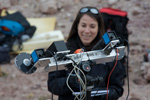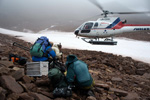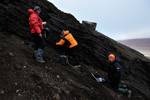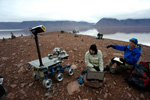The AMAS(E)ing Expedition of 2009
15 September 2009
From 1 to 24 August 2009, an international team of scientists participated in the Arctic Mars Analogue Svalbard Expedition (AMASE) in Norway, conducting scientific research and testing instruments for future ESA and NASA Mars robotic missions.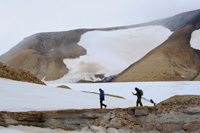 |
|
The WISDOM team at Svalbard archipelago, Norway. Credit: Storvik/AMASE |
The Svalbard archipelago is unique in the diversity of geological formations it contains. Few places in the world include so many geological eras exposed in outcrops that can be studied without removing significant amounts of soil and vegetation. Some of these formations are considered interesting test cases since the geological and physical conditions are similar to those of the Red Planet. The AMASE 2009 test sites ranged from volcanic rocks with carbonate deposits like those found on some Martian meteorites, to ancient sediments with fossilised microbial mats similar to the oldest remnants of life on Earth.
"The unusual diversity of geological sites in a high Arctic environment – and easy access by domestic flights – makes Svalbard ideally suited for testing and preparation of Mars missions", remarks Hans E.F. Amundsen, expedition leader of AMASE.
The AMASE scientists performed simulated Mars rover operations using field prototypes of instruments that will fly on future ESA and NASA missions. These included the ExoMars panoramic camera (PanCam), ground penetrating radar (WISDOM), mineral and organic chemistry spectrometer (Raman), and a Close-Up imager, and the Mars Science Laboratory (MSL) mineral and organic chemistry sensors (CheMin and SAM).
"The teams learned a lot about how their instruments work and can be used together to answer common science goals", said AMASE Science Leader Andrew Steele of the Carnegie Institution for Science in Washington, D.C. Steele is a Principal Investigator with NASA's Astrobiology Science and Technology for Exploring Planets program.
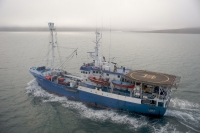 |
|
The Lance research vessel was the base for the expedition. Credit: Storvik/AMASE |
A further exercise involved a blind test with a remote science control centre, on board the research vessel Lance.
This exercise simulated several days of Mars rover activities under realistic operating conditions. A field team supplied measurements requested by a remote science team on the ship. The time pressure of receiving data from Mars, assessing the information, making key decisions on how to continue, and uploading instructions to the spacecraft was intense.
"The instruments were deployed on geologically relevant targets and were used in a sequence similar to that planned for ExoMars and MSL", comments ESA's ExoMars Project Scientist Jorge Vago, who was a member of the AMASE 2009 expedition. "After the field measurements were completed, small samples were collected and taken on board for cataloguing and further tests. The information obtained during this exercise was then compared with data collected during more detailed observations performed in the laboratories on board the Lance research vessel. This exercise was very helpful in learning what was overlooked on the field. The results can then be reviewed and used to optimise rover investigation protocols, with a view to maximising the science returns within the constraints imposed by a real Mars mission".
The AMASE expedition involved researchers from different universities and research centres, providing an excellent opportunity to perform science in environments similar to Mars, allowing interdisciplinary teams from the US and Europe to work together. While ESA and NASA are discussing options for joint robotic Mars exploration, AMASE campaigns are contributing to preparing the science groundwork and to forging long-lasting bonds among scientists and institutions.
Contacts:
Hans E.F. Amundsen, AMASE Expedition Leader
Earth and Planetary Exploration Services, Norway
Email: ha epx.no
epx.no
Andrew Steele, AMASE Science Leader
Carnegie Institution for Science in Washington, D.C., USA
Email: asteelex ciw.edu
ciw.edu
J. L. Vago, ESA ExoMars Project Scientist
Directorate of Science and Robotic Exploration, ESTEC, the Netherlands
Email: jorge.vago esa.int; Phone: +31 71 565 5211
esa.int; Phone: +31 71 565 5211
Mary A. Voytek, Senior Scientist for Astrobiology (Interim)
NASA Headquarters
Email: mary.voytek-1 nasa.gov
nasa.gov

